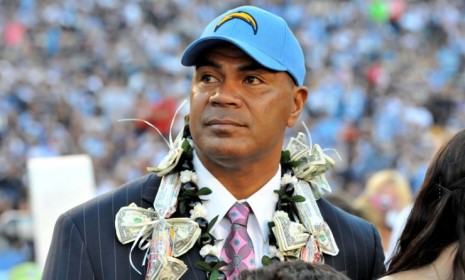Junior Seau and the disturbing NFL suicide trend
The tragic death of the 43-year-old former linebacker reignites concerns over the link between head trauma and suicide. Can anything be done?

The suicide of former NFL linebacker Junior Seau Wednesday at age 43 is once again raising questions about the links between violent NFL play, head trauma, mental illness, and suicide. After Seau's girlfriend discovered the former star at his southern California home Wednesday morning with a gunshot wound to the chest, police are investigating the incident as a suicide. If that's the case, Seau would be the second retired NFL player to commit suicide in recent weeks. Here's what you should know:
Who is Junior Seau?
He's a 12-time Pro Bowl linebacker, and generally considered "one of the best players of the 1990s," says Mike Lopresti at USA Today. He spent most of his career with the San Diego Chargers, who made it to the Super Bowl in 1994 largely thanks to him. (Eerily, Seau is the eighth member of that '94 Chargers team to die at a young age.) He finished his career with the New England Patriots, and was part of their stellar 2007 squad that lost to the New York Giants in the Super Bowl. Seau notched 1,524 tackles, 56.5 sacks, and 18 interceptions over his career, and was "a linebacker among the most feared in NFL history," says Greg Bishop and Rob Davis at The New York Times.
The Week
Escape your echo chamber. Get the facts behind the news, plus analysis from multiple perspectives.

Sign up for The Week's Free Newsletters
From our morning news briefing to a weekly Good News Newsletter, get the best of The Week delivered directly to your inbox.
From our morning news briefing to a weekly Good News Newsletter, get the best of The Week delivered directly to your inbox.
And investigators suspect suicide?
Yes. Although no suicide note was found, police believe the gunshot wound to Seau's chest was self-inflicted, and suspect no foul play. His girlfriend discovered his body when she returned from the gym. The investigation into his death is expected to extend into next week.
Could the suicide be linked to head trauma?
"The circumstances of Seau's death instantly raised comparisons to the former Chicago Bears star Dave Duerson," says Bishop and Davis. In February 2011, Duerson shot himself in the chest, leaving a note saying he wanted his brain donated to the study of football head injuries. Duerson became the banner case for what doctors believe is a link between repeated blows to the head and depression-induced suicide. Of course, we don't know if Seau's suicide was spurred by football injuries, says neurosurgeon Julian Bailes. But it's certainly possible.
A free daily email with the biggest news stories of the day – and the best features from TheWeek.com
How does head trauma cause suicide?
Largely through depression. Brain damage is a common side effect of chronic head trauma. Duerson, for one, suffered from chronic traumatic encephalopathy (CTE) — which can cause mood disturbances, depression, and unpredictable behavior. CTE has also been found in more than 20 other deceased players, though not all of them committed suicide. A study released last year showed that football players who sustain three or more concussions were significantly more likely to become depressed and five times more likely to develop Alzheimer's disease.
Did Seau exhibit any of these signs?
That's open to interpretation. In 2010, for instance, Seau drove his SUV off a 30-foot cliff just hours after he was arrested on suspicion of assaulting his girlfriend. Though he told police he had fallen asleep at the wheel, and was never charged, some interpreted the incident as a suicide attempt.
And this has happened to others besides Duerson and Seau?
Yes. On April 19, former Atlanta Falcon Ray Easterling died of a self-inflicted gunshot wound. He was a plaintiff in a high-profile lawsuit against the NFL over its handling of concussion-related injuries. (More than 1,000 former NFL players have filed lawsuits against the league for allegedly concealing possible links between football and brain injuries.) In recent years, ex-Pittsburgh Steeler Terry Long and former Philadelphia Eagle Andre Walters also took their own lives. Both suffered from CTE.
How bad is this for the NFL?
It's certainly not good. The league is transitioning into an age in which "safety has become a searing issue and the post-career problems and tragedies of former players have grown too common to ignore," says Lopresti. And the NFL is scrambling to show it's concerned with player safety. When news broke that New Orleans Saints players were paid for violent hits on opponents, Commissioner Roger Goodell drew a hard line, handing out severe suspensions and "sending messages that the culture must change."
Can anything be done?
The NFL has already begun taking steps to protect players. In 2009, the league instituted a rule requiring a player to be cleared for play by an independent neurologist after suffering a concussion. Stricter guidelines on helmet-to-helmet hits have also been imposed. But "better helmets and more flags for illegal hits aren't going to be enough," says Joel Achenbach at The Washington Post. There has to be a fundamental change in culture — from the league, the players, and the fans.
Sources: ABC News, ESPN, LA Times, Mercury News, NY Times, USA Today, Wash. Post
-
 Will the mystery of MH370 be solved?
Will the mystery of MH370 be solved?Today’s Big Question New search with underwater drones could finally locate wreckage of doomed airliner
-
 The biggest astronomy stories of 2025
The biggest astronomy stories of 2025In the spotlight From moons, to comets, to pop stars in orbit
-
 Why are micro-resolutions more likely to stick?
Why are micro-resolutions more likely to stick?In the Spotlight These smaller, achievable goals could be the key to building lasting habits